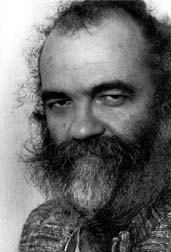| La Monte Young  Born: 14-Oct-1935 Born: 14-Oct-1935
Birthplace: Bern, ID
Gender: Male
Religion: Mormon
Race or Ethnicity: White
Sexual orientation: Straight
Occupation: Composer Nationality: United States
Executive summary: Minimalist composer The first composer to have created music made up entirely of long sustained tones and arguably the founder of the "minimalist" musical style, though his work bears little resemblence to that of later, better-known figures such as Philip Glass, Steve Reich and Terry Riley.
Raised a Mormon, Young claims that the first sound he can remember hearing was wind whistling through the Idaho log cabin he was born in, and that during childhood he became fascinated by the humming of step-down power transformers and telephone poles (sounds which would clearly influence him later in life). In 1940 his family moved to LA, where he tapdanced and performed "cowboy songs" to earn money. Later, in high school and college (UCLA and UC Berkeley), he joined several jazz groups playing alto sax (and apparently had a fan in Ornette Coleman). However, by 1957 he had abandoned jazz in favor of his compositional studies.
Young caught on quickly to the contemporary academic music of the time, showing special interest in the 12-tone music of Anton Webern. He also held a strong enthusiasm for world music, especially Japanese gagaku and traditional Indian raga, and the feeling of musical "stasis" produced by both would strongly impact the landmark 1958 Trio for Strings, a 12-tone piece made up entirely of sustained pitches. The work was played at the home of his instructor Seymour Schiffrin (who despised it) and witnessed by several other students, notably Pauline Oliveros, David Del Tredici, and Young's friend Terry Riley. This was, in effect, the birth of minimalism, though its implications would not be realized until somewhat later.
In 1959 Young went to Darmstadt to study for the summer with Karlheinz Stockhausen; David Tudor was also in attendance, and through him Young was exposed to the philosophy and music of John Cage. Finding the atmosphere at Berkeley too conservative upon his return, Young was given a travel grant to move to New York in 1960, and there he teamed up with Cage as well as Yoko Ono, Henry Flynt, and Fluxus founder George Maciunas. Here he curated various concerts and also composed an influential set of conceptual pieces, including the Compositions 1960 (ex. #15, "This piece is little whirlpools out in the middle of the ocean."). Still unsatisfied, however, he disassociated himself from the concept art scene around 1962 and returned to his roots in jazz and blues, improvising over long sustained chords with his friend Terry Jennings. Out of this grew The Theater of Eternal Music.
Originally a kind of Indian-influenced jazz band, with the addition of mathematician and violinist Tony Conrad, violist John Cale, and drummer Angus Maclise (all future The Velvet Underground members), as well as Young's wife Marian Zazeela (and later Terry Riley), TTOEM transformed itself to focus exclusively on playing loud, punishing drones (tuned in just intonation) for long periods of time. By '66 they had splintered over authorship conflicts (Young claims that the music was composed by him, while Conrad and Cale claim that it was communally created) but the group had already laid the groundwork for minimalism in its mature form, to be picked up later by Riley, Reich, and others.
Young moved on, working on his Dream House (a long-term sound and lighting environment) and studying with the Indian master vocalist Pandit Pran Nath. In 1974 he resumed work on an abandoned piece from a decade earlier, The Well-Tuned Piano (a pun on Bach's Well-Tempered Clavier), a semi-improvisatory work for solo piano in Young's own unique tuning. Originally a brief 45 minutes, Young continuously played, adjusted, and expanded Piano up until its final 1987 performance, which lasted a monumental six and a half hours (he's in the Guinness Book of World Records, folks). More recently his work hasn't been quite as ambitious; during the '90s he presided over two recreated "Theater of Eternal Music" ensembles (one brass and one strings), briefly formed the Forever Bad Blues Band (returning once again to Young's roots in jazz and blues), and studied classical Indian singing until Pran Nath's death in 1996. He still lives in New York and continues to write music, tutor students, maintain a sound installation, play concerts of both classical raga and his own work, and release recordings via his private record label. Wife: Marian Zazeela (m. 1963)
Guggenheim Fellowship 1966
Fluxus
Official Website:
http://melafoundation.org/lmy.htm
Is the subject of books:
Sound and Light: La Monte Young & Marian Zazeela, 1996, BY: ed. William Duckworth and Richard Fleming
Requires Flash 7+ and Javascript.
Do you know something we don't?
Submit a correction or make a comment about this profile
Copyright ©2019 Soylent Communications
|